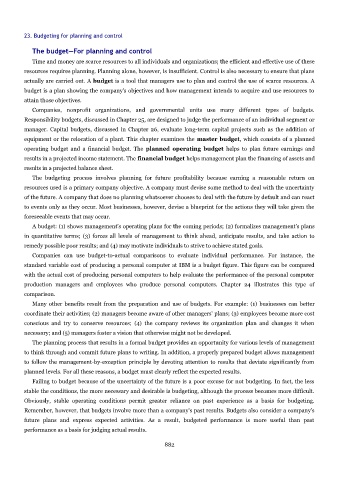Page 881 - Accounting Principles (A Business Perspective)
P. 881
23. Budgeting for planning and control
The budget—For planning and control
Time and money are scarce resources to all individuals and organizations; the efficient and effective use of these
resources requires planning. Planning alone, however, is insufficient. Control is also necessary to ensure that plans
actually are carried out. A budget is a tool that managers use to plan and control the use of scarce resources. A
budget is a plan showing the company's objectives and how management intends to acquire and use resources to
attain those objectives.
Companies, nonprofit organizations, and governmental units use many different types of budgets.
Responsibility budgets, discussed in Chapter 25, are designed to judge the performance of an individual segment or
manager. Capital budgets, discussed in Chapter 26, evaluate long-term capital projects such as the addition of
equipment or the relocation of a plant. This chapter examines the master budget, which consists of a planned
operating budget and a financial budget. The planned operating budget helps to plan future earnings and
results in a projected income statement. The financial budget helps management plan the financing of assets and
results in a projected balance sheet.
The budgeting process involves planning for future profitability because earning a reasonable return on
resources used is a primary company objective. A company must devise some method to deal with the uncertainty
of the future. A company that does no planning whatsoever chooses to deal with the future by default and can react
to events only as they occur. Most businesses, however, devise a blueprint for the actions they will take given the
foreseeable events that may occur.
A budget: (1) shows management's operating plans for the coming periods; (2) formalizes management's plans
in quantitative terms; (3) forces all levels of management to think ahead, anticipate results, and take action to
remedy possible poor results; and (4) may motivate individuals to strive to achieve stated goals.
Companies can use budget-to-actual comparisons to evaluate individual performance. For instance, the
standard variable cost of producing a personal computer at IBM is a budget figure. This figure can be compared
with the actual cost of producing personal computers to help evaluate the performance of the personal computer
production managers and employees who produce personal computers. Chapter 24 illustrates this type of
comparison.
Many other benefits result from the preparation and use of budgets. For example: (1) businesses can better
coordinate their activities; (2) managers become aware of other managers' plans; (3) employees become more cost
conscious and try to conserve resources; (4) the company reviews its organization plan and changes it when
necessary; and (5) managers foster a vision that otherwise might not be developed.
The planning process that results in a formal budget provides an opportunity for various levels of management
to think through and commit future plans to writing. In addition, a properly prepared budget allows management
to follow the management-by-exception principle by devoting attention to results that deviate significantly from
planned levels. For all these reasons, a budget must clearly reflect the expected results.
Failing to budget because of the uncertainty of the future is a poor excuse for not budgeting. In fact, the less
stable the conditions, the more necessary and desirable is budgeting, although the process becomes more difficult.
Obviously, stable operating conditions permit greater reliance on past experience as a basis for budgeting.
Remember, however, that budgets involve more than a company's past results. Budgets also consider a company's
future plans and express expected activities. As a result, budgeted performance is more useful than past
performance as a basis for judging actual results.
882

